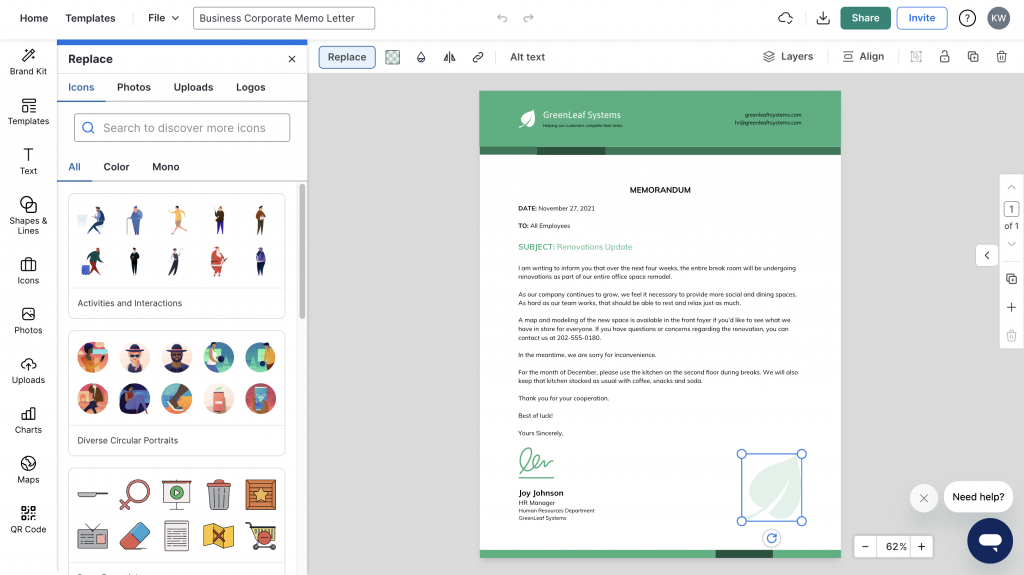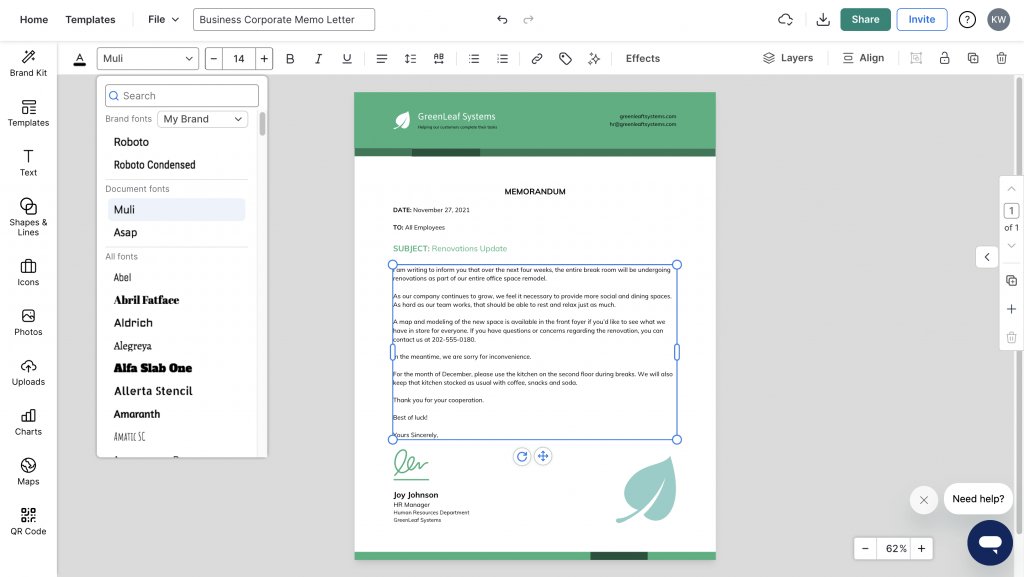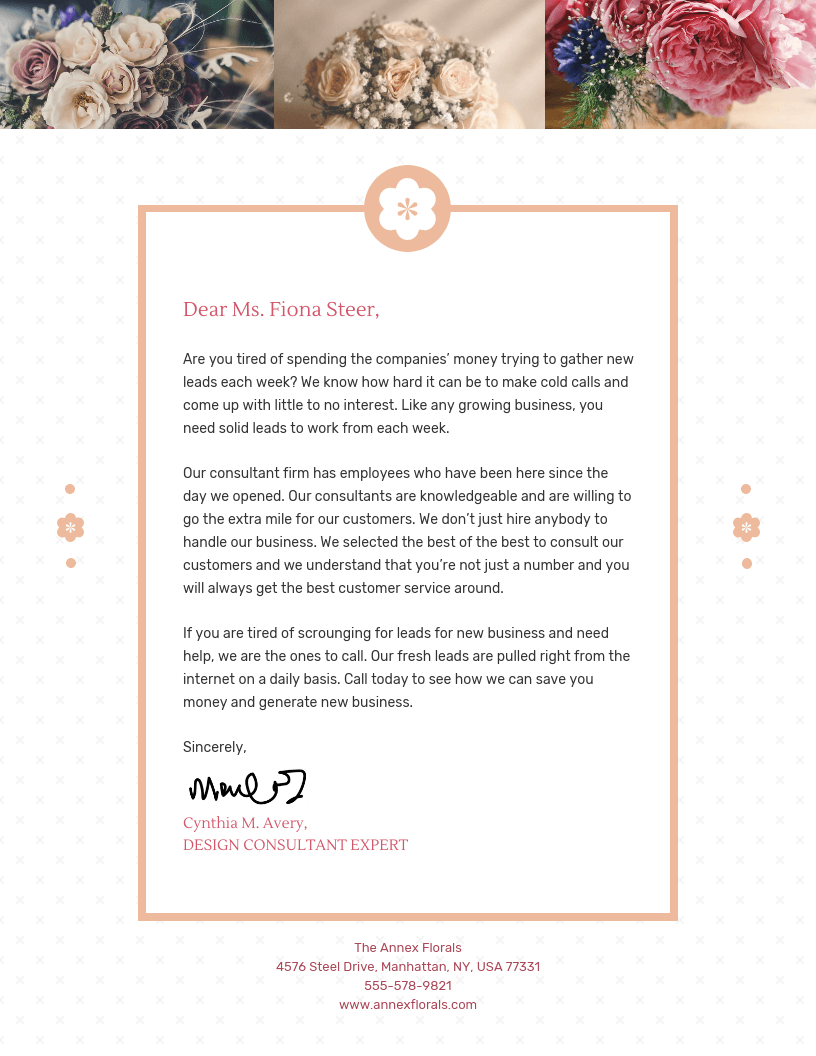
Business letterheads may seem like something that should stay in the era of fax machines and pagers, but it’s still as important today as it was back then.
That’s because having a company letterhead is the cornerstone of professional communication. Plus, it ensures your brand stays consistent across departments and teams.
But don’t worry: learning how to make a letterhead is easier than you think.
Below I cover how to make a letterhead in five easy steps, plus design tips, letterhead templates and tutorials on how to use your new letterhead in Word or Google Docs.
Click to jump ahead:
- What is a letterhead?
- Why use a letterhead?
- How to create a letterhead in 5 steps
- Letterhead design tips
- Letterhead design FAQ
Keep scrolling for the full tutorial or watch this video for some quick tips on how to design a letterhead:
What is a letterhead?
A letterhead is a document template containing your company contact information and branding with space for a custom message. Letterhead is either printed for postal mail or used digitally.
Letterhead may also have a specific employee’s contact information, especially if it’s requesting a reply, or about a specific issue for select recipients instead of being a company-wide announcement.
Here’s an example of a simple yet stylish business letterhead template:
Why use a letterhead?
Letterhead with your branding makes you look more professional, which inspires customers to trust you. It also makes you seem more legit to vendors, or creditors such as your bank.
More than optics, using a letterhead adds a sense of authority. Reading a message on a letterhead — even a digital version — is much more formal than reading an email. For this reason, always use letterhead for official company communications.
Letterhead is commonly used for:
- Transactional reports, like account statements or quarterly performance metrics.
- Big news, like an acquisition or merger.
- Policy changes, such as price adjustments or changes that influence a customer’s account or experience.
- Personal messages from the CEO or other executives.
- Job offers and other human resources correspondence.
How to create a letterhead in 5 steps with Venngage
1. Sign up for a free Venngage account
Sure, you can make your letterhead directly in Word, but do you really want to be haunted by the ghost of Clippy spend hours designing a layout from scratch?
Be kind to yourself: sign up for a free Venngage account.
It only takes a few seconds and we even pull in your logo and brand colors from your website automagically for you (or add it yourself later).

2. Choose a letterhead template
Now the fun part: pick a letterhead to customize. Browse our collection of professionally designed letterhead templates.
Our Premium and Business users have access to exclusive templates, but we have plenty of free ones, too. Using our drag-and-drop editor is always free. But note, downloads are only available for Premium or Business users.
Use the filter by plan type, see the newest templates first or sort by size.

Hover over a design and click Preview to see it full-size. Click Create on the one you want to use.

3. Add your branding and contact information
Now it’s time to make your new letterhead. Click on any element to edit it.
Start with the text fields, like name and address, and replace it with your company info. One click selects the text box, and another click allows you to edit the text inside.
You can even use familiar keyboard shortcuts, like Ctrl+B for bold text, or use the top menu buttons.

To edit an image, click it and choose Replace in the top menu.

Replace gives you three options: swap in one of the 20,000+ icons in our library, add a royalty-free stock photo or upload your own image.

To change an element’s color, click it, then choose the color icon in the top menu. You can specify a HEX color code or select one with the color wheel. Hit the plus sign to save the current color to your swatches for easy access.

Okay, you’ve got your logo and brand colors, now the last piece is customizing the font.
To change the font, click on a text area, select all the existing text within and choose a new font from the top menu.
Chances are your brand font is already available, but if not, you can upload its font file (.OTF or .TTF) so your new letterhead matches your brand perfectly 🤌.

4. Add, remove or rearrange elements (optional)
To add a new icon, stock photo or your own graphic to the letterhead, use the menu along the left side.
You can also add charts and diagrams, and even embed a map, YouTube video, form and so much more. Clearly, none of those belong here — but you could try making an infographic, or a presentation template once you’re done making your letterhead.
Click and drag any element around to move it, or use the grabby points to make it bigger or smaller. When you move an item around, grid lines will appear to help you align it with other elements in your design, keeping everything looking neat and professional.
Made a mistake or don’t like the result? Just hit Undo in the top menu.

5. Print, download or save as a custom template
When you’re happy with your edits, click Preview to see how it looks if you were to print it out. All good? Click the share icon to publish it online, or if you’re on a Premium or Business plan, hit Download to grab a copy to go and you’re done!
Bonus! Premium and Business users can also save designs as custom templates, collaborate with team members and access My Brand Kit.

Want to use your new letterhead template in Word or Google Docs? Read on, I’ve got tutorials below.
Here are five tips for designing a letterhead
1. Be consistent with branding
Your letterhead’s solid neon yellow background may look super sweet, but unless that’s actually your brand color, it’s best not to burn anyone’s retinas off. Tone it down a smidgen.
Branding goes further than colors and logos, too. It’s about ✨vibes.✨
Is your brand serious and stoic? Stick to simple, classic letterhead templates, like this:
On the other hand, if your brand is a lil’ out there, go ahead and make the spiciest letterhead the world has ever seen.
Swirly fonts and an abstract painting in the background? Woo.
This template is still professional. It’s just more “artsy” than the previous one. Both are great templates, but suit very different brand identities.
The key is knowing what your brand portrays and creating materials that match not only your look, but also your feel.
2. Keep the top of your letterhead minimal
Repeat after me: “A letterhead is not a resume. I don’t need to put my contact information super big at the top.”
Contact information is an important part of your letterhead but the most important part is the actual message it’s communicating. If possible, keep the top of your letterhead minimal with only your logo and the date. This directs the reader right into your content.
Keep everything else at the bottom: your contact information, website, tagline, social icons, etc. — anything that’s not a logo or the date.
This template has a minimal logo at the top right, which naturally draws the eye toward the fuller left side to start reading the letter right away.
3. Try a bold border
Again, this may not fit your brand. We can’t all be Flamin’ Hot Cheetos. Some of us are accountants… not that there’s anything wrong with that.
But if you fancy a bold style, a colorful border adds a fun twist. Try adding a border around your entire letterhead, or just on one side.
This letterhead would certainly stand out in a stack of black and white competitors.
4. Use a photo
Photos can make your letterhead stand out and also instantly communicate what you do. But, they’re best used for digital letterheads vs. printed ones.
Save the trees (and your ink tanks).
Our letterhead maker features thousands of royalty-free, professional stock photos from Pexels and Pixabay, or upload your own. Like a template but not the photo? You can swap any image for a new one.
Try using a photo as a background (adjust the opacity to keep text legible!) or better yet: upload real photos of your work. Real photos are a perfect way for service providers to turn a letterhead into a mini-portfolio, too.
5. Add an illustration
Looking for a more artistic option? Add an illustration that represents your business from our library of over 20,000 options. Or upload your own artwork.
You can easily change the color of our mono-colored icons and illustrations to match your brand using the color picker. Additionally, many of our people icons are available in a full range of skin tones. Look for the skin tone icon in the corner.

To change skin tone, add the illustration to your letterhead, then click the Skin Tone icon in the top menu.

Not sure which illustration could represent your business? I love this template incorporating a skyline — the London Eye, to be exact. A skyline silhouette is perfect for festivals or local non-profits.
It doesn’t need to be this big, though. Smaller illustrations add a unique flair and are perfect for a subtle background. You can adjust the opacity so they don’t overpower the rest of your template.
Yeah, if you could go ahead and keep it to one or two pieces of flair, that’d be great.
Letterhead design FAQ
What must be included in a letterhead?
I mean, it’s not the law or anything, but your letterhead should 100% have your company’s:
- Name
- Address
- Main phone number
- General or customer service email address
- Logo
- Professional license numbers or memberships (if applicable)
Our business letterhead templates already have everything you need built-in so you can customize and go.
How to make a professional letterhead in Word?
You have two options:
- Painstakingly position each element of your letterhead in Word, cursing every time it shifts something out of place (and it will, trust me).
- Download your customized letterhead from Venngage and add it to Word with two clicks, then reward your ingenuity with an iced coffee.
Here’s how to do option two:
- Make a letterhead template in Venngage. Download it as an image (.JPG or .PNG).
- Open up a new, blank Word document.
- Click on the Design tab (some versions call it Layout), then Watermark.
- Choose the Picture watermark option, and upload your saved letterhead image file.
- It may show up faded in your document. To fix this, uncheck the Washout checkbox.
- You should see a crisp, clear version of your letterhead ready to use in Word. Save this document as your letterhead template and duplicate it whenever you need to use it.
- Don’t forget that iced coffee — you deserve it.
How can you make a letterhead in Google Docs?
- Open a new Google Docs file.
- In the top menu, click Insert then Watermark.

- Upload your letterhead image file. Leave the Faded box unchecked.

- Ta-da! Alternatively, you can add separate header and footer images in Google Docs instead of adding a full background image. To do that, click Insert -> Headers & Footers -> Header, insert the image, then do the same for the Footer option.
What if I need my letterhead in a different size?
You can easily resize any template in Venngage. Click on Page Size in the top menu (the gear icon).
Choose common paper sizes from the dropdown, enter your own or switch between portrait or landscape mode.
How to make a letterhead template in 5 minutes
Uplift your personal or corporate business branding with a custom, professional letterhead.
To recap, here’s how to make a letterhead:
- Step 1: sign up for a free Venngage account
- Step 2: choose a letterhead template
- Step 3: add your branding and contact information
- Step 4: add, remove or rearrange elements
- Step 5: print, download or save as a custom template
It’s that easy to make a letterhead with Venngage — and share it with your whole team — so grab your logo, brand color(s) and get to it!
















































